Last updated on December 2nd, 2011
 WHO’S THE STAR OF MY VEGETABLE GARDEN JUST NOW? Definitely Amaranthus hypochondriacus. I planted this ‘Golden Giant’ as an experiment back in June. So far, it has not disappointed. Not only has the plant achieved a height of nearly 9 feet in just 8 weeks’ time, it is flowering right on cue, too. Pictures of the plant’s progression from seed to skyscraper, and why its golden-orange plumes (above) are so vital to any subsistence garden:
WHO’S THE STAR OF MY VEGETABLE GARDEN JUST NOW? Definitely Amaranthus hypochondriacus. I planted this ‘Golden Giant’ as an experiment back in June. So far, it has not disappointed. Not only has the plant achieved a height of nearly 9 feet in just 8 weeks’ time, it is flowering right on cue, too. Pictures of the plant’s progression from seed to skyscraper, and why its golden-orange plumes (above) are so vital to any subsistence garden:
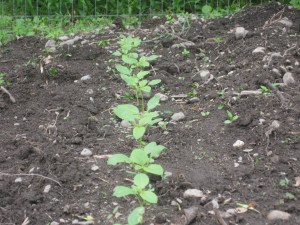 I created a special little annex off the Kitchen Garden for my crop of Golden Giant. Weeds were cleared, but the soil received no amendments whatsoever. The seeds, which were planted on June first, germinated within 5 days. In the photo above, taken on June 12, they’d achieved only 3 inches in height.
I created a special little annex off the Kitchen Garden for my crop of Golden Giant. Weeds were cleared, but the soil received no amendments whatsoever. The seeds, which were planted on June first, germinated within 5 days. In the photo above, taken on June 12, they’d achieved only 3 inches in height.
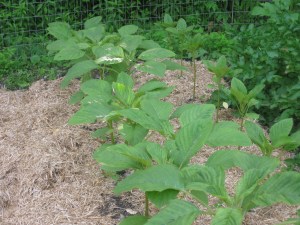 July 4. The seedlings, now 12 inches tall, were thinned out to make two rows. Although the transplants wilted at first, I sprinkled them twice daily with water, and they quickly recovered. A thick mulch of salt-hay substitute was laid down at this time, and surplus potatoes were added behind the amaranth.
July 4. The seedlings, now 12 inches tall, were thinned out to make two rows. Although the transplants wilted at first, I sprinkled them twice daily with water, and they quickly recovered. A thick mulch of salt-hay substitute was laid down at this time, and surplus potatoes were added behind the amaranth.
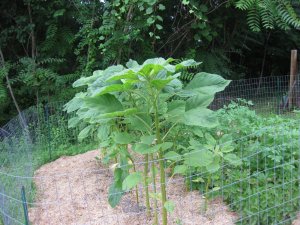 July 18. The plants have really gained stature now, as warm weather finally settles in. Amaranth is a heat lover. Based on the height of the 4-foot tall fence, I’d say the plants above are 6 feet tall.
July 18. The plants have really gained stature now, as warm weather finally settles in. Amaranth is a heat lover. Based on the height of the 4-foot tall fence, I’d say the plants above are 6 feet tall.
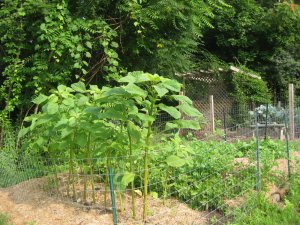 July 21. By now, growth is occurring daily. The plants are 7 feet tall, and they are starting to produce flower buds.
July 21. By now, growth is occurring daily. The plants are 7 feet tall, and they are starting to produce flower buds.
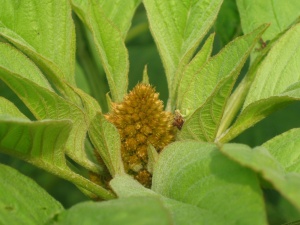 July 21. My heart skipped a beat when I saw this first, tiny flower bud.
July 21. My heart skipped a beat when I saw this first, tiny flower bud.
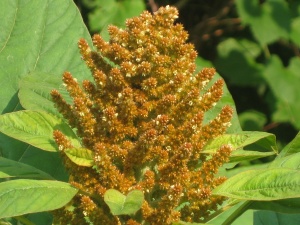 August 2. The plants, now 9 feet tall, are all topped with flowers. I climbed a ladder to photograph the one pictured above.
August 2. The plants, now 9 feet tall, are all topped with flowers. I climbed a ladder to photograph the one pictured above.
Talk about flower power! In late September, the giant plumes turn into giant seed heads. These seeds, once harvested and winnowed, are used exactly like grain. Except amaranth, which is gluten-free, has more protein, vitamins and minerals than most other grains. It also has twice the calcium of milk. I intend to boil the seeds for a highly-nutritious breakfast cereal. Seeds can also be popped like popcorn, or milled for flour.
My advice? Consider growing amaranth in your garden next year. Just think of the food you’ll get: up to one pound of grain per plant. You can even grow your crop in tight quarters, for although Golden Giant is tall, it isn’t fat. I spaced mine just 12 inches apart. Full sun and weekly watering are its only cultural requests.
Don’t miss anything at A Garden for the House…sign up for Kevin’s weekly newsletter.
Related Posts:
My Guide to a Fantastic Fall Harvest
Zucchini-mania
Things My Brussels Sprouts Taught Me
Why Your Food Prices Will Double in 2011
What Would You Plant in Your Subsistence Garden?

Katreader says
Amazing!
Cary says
Wow! Kevin, you'd mentioned growing amaranth about the time I found your blog and I filed that in my brain, but got lost enjoying the older posts here, and forgot to come back to it. I bought amaranth seeds a few years ago, but never planted them, so I perked up when you'd mentioned planting. Thanks so much for the pictorial history. Do you remember who you bought the seeds from? Thanks sooo much! and congratulations on your great crop. Please share harvest and winnowing story too!
Kevin Lee Jacobs says
Cary – I look forward to harvesting and winnowing the seeds. Will certainly share the experience here!
My 'Golden Giant' amaranth came from Seeds of Change (dot) com.
Broken Barn Industries says
I've been growing ornamental amaranth for years- caudatus from Botanical Interests. Can I eat that as well? I love how it self seeds and I love how the “dreadlocks” look in a vase.
Kevin Lee Jacobs says
BBI – From what I've read, seeds and leaves of A. caudatus, or “Love Lies Bleeding,” are indeed edible. Seeds must be cooked before eating.
Terry says
That is amazing! Do they stand tall on their own, do they need staking at all?
Kevin Lee Jacobs says
Terry – Mercifully, they have required no staking.
Yaxue says
Amazing! Want to try too, but the problem is I only have so many arable square feet… Still it's good to know where you got the seeds just in case.
Lurking around most of the time, I have been thoroughly enjoying your posts and, as the the fall approaches, will be use your blog as a planting guide–what to plant and when 🙂
Thanks, Kevin.
Kevin Lee Jacobs says
Yaxue – Thanks for your kind words. So glad you find this site helpful.
As for amaranth, you will find these require very little space. I've given mine 12 square inches each, and they are thriving happily.
The Japanese Redneck says
I don't guess I'ver ever eaten it. Very interesting though.
Kevin Lee Jacobs says
The Japanese Redneck – If you'd like to taste amaranth, visit your local health-food store. They will have cereals and other things made from this grain. Unfortunately these products will be very expensive. Ah! Another good reason to grow amaranth!
despina says
I love the taste of amaranth. Kevin, will you post recipes for those of us who are baking/cooking challenged?
Kevin Lee Jacobs says
despina – Once I've harvested and winnowed the grain, I will indeed post recipes. Thanks for asking!
Bill says
I read that the leaves, stalk, and roots are edible, as well. The leaves are supposed to taste like and be prepared like spinach, but I don’t know about the stalks and roots. Guess you could juice those for green smoothies.
Nice article you wrote about this.
Bill